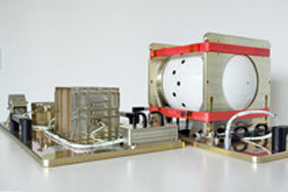
[SatNews] The European space freighter “Georges Lemaître” is ready for its trip to the International Space Station ISS.
An Ariane 5 rocket is scheduled to carry the ATV (Automated Transfer Vehicle) into space on July 2th. RUAG supplied numerous assemblies for this, the last of the five European ATVs, as well as a camera that will record the freighter’s re-entry into the Earth’s atmosphere.
A special version of the European Ariane 5 launcher will carry “Georges Lemaître” into space. In a fully automated maneuver, “Georges Lemaître” is then scheduled to dock with the ISS’s Russian Zvezda module on August 12th. The unmanned transporter will deliver a total of 6.6 tons of cargo to the ISS, bringing scientific equipment and fuel for the station as well as food and water for the astronauts on board. “Georges Lemaître” will remain docked with the ISS for approximately one-half a year. During that time, the ATV will function as a storage area as well as will use its engines to help the ISS—which slows and sinks over time—to accelerate again and reach a higher orbit. At the end of its service life, “Georges Lemaître” will become a cosmic waste incinerator: the astronauts will fill their trash into the ATV, which will then undock and burn up upon re-entering Earth’s atmosphere.

Photo of the "ATV Breakup Camera." Photo is courtesy of RUAG Space.
This reentry will be recorded by an infrared camera built by RUAG Space. What has been dubbed the "ATV Breakup Camera" is to document how the ATV’s interior structure heats up before frictional heat and air resistance cause the craft to break and burn up. Right up until the point at which the camera itself is destroyed as it reenters our atmosphere, the camera will maintain a feed of images to a communication unit. This unit is encased in a spherical ceramic shield that will protect it from the extreme heat. Before this ceramic ball plunges into the ocean, the unit inside will transmit the video footage to Earth via the Iridium network of communications satellites. RUAG Space will collaborate with ETH Zurich to evaluate the images.
The expectation is that the video footage will provide insight into exactly what happens when a large spacecraft breaks up. The knowledge gained will also help to build large satellites and spacecraft is such a way that they burn up completely upon re-entering the Earth’s atmosphere at the end of their service lives.
RUAG Space also played a key role in developing and constructing the ATV, having developed and built the framework for the propulsion module. This complex aluminium structure is the backbone around which the ATV is built. RUAG Space was also responsible for manufacturing eight cargo racks. The company’s Swedish subsidiary, RUAG Space AB, supplied the ATV’s Monitoring and Safing Unit. This highly reliable computer oversees the safety of the autonomous docking maneuver.
The RUAG Space infosite may be accessed at http://www.ruag.com/

